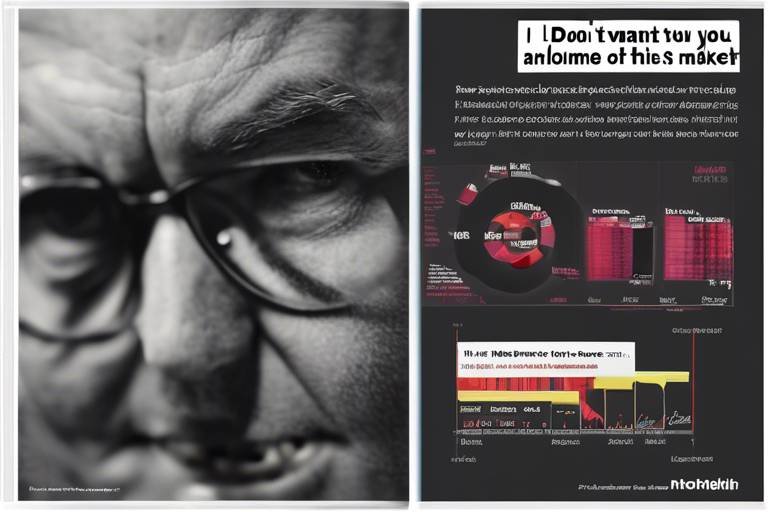The Role of Financial Derivatives in Crypto Risk Management
In the ever-evolving world of cryptocurrency, where prices can swing wildly from day to day, managing risk has become a crucial component for investors and traders alike. Enter financial derivatives, powerful tools that can help navigate the turbulent waters of crypto investments. But what exactly are these derivatives, and how can they be leveraged to safeguard your assets? In this article, we will dive deep into the significance of financial derivatives in managing crypto risks, exploring their types, benefits, and the strategies that can enhance your trading experience.
Financial derivatives are essentially contracts whose value is derived from an underlying asset, such as cryptocurrencies, stocks, or commodities. They allow traders to speculate on the future price movements of these assets without actually owning them. Think of derivatives as a kind of financial insurance policy: they can protect your investments from adverse price changes while also offering opportunities for profit. In the crypto sector, where volatility is the norm, derivatives play a pivotal role in risk management, enabling traders to hedge their positions and mitigate potential losses.
When it comes to cryptocurrency, several types of financial derivatives are commonly used. Each has its unique features and applications:
- Futures Contracts: Agreements to buy or sell an asset at a predetermined price at a future date.
- Options Contracts: Give the holder the right, but not the obligation, to buy or sell an asset.
- Swaps: Contracts to exchange cash flows or other financial instruments between parties.
Understanding these derivatives is essential for anyone looking to navigate the crypto markets effectively. Let’s take a closer look at futures contracts, one of the most popular derivatives in the crypto space.
Futures contracts are agreements to buy or sell an asset at a predetermined price at a specified time in the future. In the context of cryptocurrencies, these contracts allow traders to lock in prices and hedge against potential losses due to price fluctuations. For instance, if a trader believes that the price of Bitcoin will rise, they can enter into a futures contract to buy it at a lower price now, effectively securing their profits if the market moves in their favor.
The use of futures contracts in cryptocurrency trading comes with several advantages:
- Leverage: Futures allow traders to control a larger position with a smaller amount of capital, magnifying potential gains.
- Liquidity: The futures market is often more liquid than the spot market, providing better opportunities for entering and exiting trades.
- Price Discovery: Futures help in establishing a market price for cryptocurrencies, which can guide traders in their decisions.
However, as with any financial instrument, there are risks involved.
While futures contracts offer significant benefits, they also come with their share of risks. The primary concern is the potential for substantial losses, especially in a highly volatile market like cryptocurrency. Traders can be caught off guard by sudden price swings, leading to margin calls and forced liquidations. To mitigate these risks, it’s essential to employ sound risk management strategies, such as setting stop-loss orders and diversifying your portfolio.
Options contracts provide a different approach to risk management. They grant the holder the right, but not the obligation, to buy or sell an asset at a specified price within a certain timeframe. This flexibility makes options an attractive choice for crypto investors looking to hedge against market fluctuations without committing to a trade outright. For example, if you own Bitcoin and fear a price drop, purchasing a put option can protect your investment by allowing you to sell at a predetermined price, even if the market declines.
To effectively manage risks in cryptocurrency trading, integrating financial derivatives into your strategy is essential. Let’s explore some of the most effective risk management strategies:
Hedging is a common practice in risk management, and it can be effectively achieved using derivatives. By taking a position in a derivative that offsets potential losses in your underlying asset, you can protect your investments from adverse price movements. For instance, if you hold a significant amount of Ethereum, you might consider using futures contracts to hedge against potential declines in its value.
Understanding the difference between speculation and hedging is crucial for any trader. While hedging aims to minimize risk, speculation involves taking on risk for the potential of higher returns. Traders can use derivatives for both purposes, but it’s essential to balance risk exposure effectively. This balance can be achieved by setting clear goals and using risk management tools to protect your capital.
- What are financial derivatives? Financial derivatives are contracts that derive their value from an underlying asset.
- How do futures contracts work? Futures contracts involve agreeing to buy or sell an asset at a predetermined price at a future date.
- What are the risks of using options contracts? The primary risks include the potential for losing the premium paid for the option and market volatility affecting the underlying asset's price.
- Can derivatives be used for both hedging and speculation? Yes, derivatives can be used for both purposes, but it’s crucial to understand the associated risks.

Understanding Financial Derivatives
Financial derivatives are fascinating instruments in the world of finance, acting as contracts whose value is derived from the performance of underlying assets. In simpler terms, think of them as a ticket to a concert; the ticket's value is tied to the event, much like derivatives are tied to assets like stocks, bonds, or, in our case, cryptocurrencies. These derivatives play a crucial role in the financial markets, particularly in the volatile and often unpredictable realm of cryptocurrencies. By allowing traders to speculate on price movements without actually owning the underlying asset, derivatives provide a unique way to manage risk and enhance trading strategies.
In the cryptocurrency sector, where price swings can be as dramatic as a rollercoaster ride, derivatives offer traders tools to safeguard their investments. They function by allowing investors to enter into agreements that can either hedge against potential losses or speculate on price increases. Understanding how these financial instruments work is essential for anyone looking to navigate the choppy waters of crypto trading.
To break it down further, let’s consider the main types of financial derivatives used in crypto trading:
- Futures: Contracts that obligate the buyer to purchase, or the seller to sell, an asset at a predetermined price at a specified time in the future.
- Options: Contracts that give the holder the right, but not the obligation, to buy or sell an asset at a specified price before a certain date.
- Swaps: Agreements to exchange cash flows or other financial instruments over a specified period.
Each of these derivatives serves a specific purpose in risk management. For instance, futures can help in locking in prices, which is especially beneficial in a market as volatile as cryptocurrency. On the other hand, options provide flexibility, allowing traders to benefit from price movements without the obligation to buy or sell. Swaps can be used for various purposes, including managing interest rate risk or currency risk.
Overall, the understanding of financial derivatives is not just for seasoned traders; it’s a necessary skill for anyone looking to invest in cryptocurrencies. By grasping how these derivatives work, investors can make informed decisions that not only protect their capital but also open up opportunities for profit in a market that never sleeps. The key takeaway here is that financial derivatives, while complex, are essential tools in the arsenal of any crypto trader aiming to manage risk effectively.

Types of Financial Derivatives in Crypto
When diving into the world of cryptocurrencies, it's essential to grasp the various financial derivatives available in the market. These derivatives serve as powerful tools for traders and investors, enabling them to navigate the often turbulent waters of crypto trading. Essentially, financial derivatives are contracts whose value is tied to the performance of an underlying asset, in this case, cryptocurrencies. Understanding these instruments can significantly enhance your ability to manage risks and optimize your investment strategies.
Among the most common types of financial derivatives in the crypto space are futures contracts, options contracts, and swaps. Each of these derivatives has unique characteristics and applications that cater to different trading strategies. Let's take a closer look at these types:
| Type of Derivative | Description | Common Use |
|---|---|---|
| Futures Contracts | Agreements to buy or sell an asset at a predetermined price at a future date. | Hedging against price volatility and speculating on price movements. |
| Options Contracts | Contracts that give the holder the right, but not the obligation, to buy or sell an asset. | Managing risk while retaining the potential for profit. |
| Swaps | Contracts in which two parties exchange cash flows or other financial instruments. | Managing interest rate or currency risks associated with crypto investments. |
Futures contracts are particularly popular among traders looking to hedge against potential losses or to speculate on future price movements. These contracts allow traders to lock in prices, which can be a lifesaver during periods of high volatility. On the other hand, options contracts offer more flexibility, as they provide the right to execute a trade without the obligation to do so. This can be advantageous for traders who want to limit their risk exposure while still having the opportunity to profit from favorable market movements.
Swaps, although less common in the crypto market compared to traditional finance, are gaining traction. They allow parties to exchange financial instruments, which can be particularly useful for managing risks associated with interest rates or currency fluctuations in a crypto portfolio. Each of these derivatives plays a vital role in the crypto ecosystem, and understanding their functions can empower traders to make more informed decisions.
In summary, the landscape of financial derivatives in the cryptocurrency market is diverse and continually evolving. By familiarizing yourself with futures, options, and swaps, you can harness these tools to mitigate risks and enhance your trading strategies. As the crypto market matures, the use of these derivatives will likely become even more prevalent, making it crucial for investors to stay informed and adaptable.

Futures Contracts
Futures contracts are essential tools in the world of cryptocurrency trading, acting as agreements to buy or sell an asset at a predetermined price on a specified future date. Imagine you're planning a big party and you want to buy a cake for $50. You make a deal with the baker today, agreeing to pay that price even if the cost goes up by the time your party arrives. That's how futures work! In the context of cryptocurrencies, these contracts allow traders to lock in prices, providing a safeguard against the notorious price volatility that characterizes the crypto market.
When you enter into a futures contract, you’re essentially betting on the future price of a cryptocurrency. If you believe that Bitcoin will rise in value, you can purchase a futures contract today at a lower price, and if your prediction comes true, you can sell it at a profit later. Conversely, if you think the price will drop, you can sell a futures contract, allowing you to profit from the decline. This dual functionality makes futures contracts incredibly versatile for traders seeking to manage risk.
Furthermore, futures contracts come with their own set of advantages. They offer significant leverage, meaning you can control a larger position with a relatively small amount of capital. This can amplify gains, but it also increases risk, so it’s crucial to tread carefully. Additionally, the liquidity in the futures market is often higher than in the spot market, which means that traders can enter and exit positions with greater ease. The combination of leverage and liquidity can enhance trading strategies, making futures an attractive option for both new and seasoned traders alike.
However, it’s important to recognize that trading futures is not without its risks. The crypto market is notoriously volatile, and while futures can help manage that risk, they can also exacerbate losses. If the market moves against your position, you could find yourself facing substantial losses, sometimes even more than your initial investment. Therefore, understanding the mechanics of futures contracts and employing sound risk management strategies is essential for anyone looking to engage in this type of trading.
In summary, futures contracts are a powerful tool in the cryptocurrency trading arsenal. They allow traders to speculate on future price movements while providing mechanisms for risk management. However, like any financial instrument, they require a solid understanding and careful consideration to navigate the inherent risks effectively.

Advantages of Futures in Crypto
When it comes to trading cryptocurrencies, the volatility can be both a blessing and a curse. However, utilizing futures contracts can significantly enhance your trading strategy by offering several key advantages. One of the most compelling benefits is the ability to leverage your investments. With futures, traders can control a large amount of cryptocurrency with a relatively small margin. This means that even a slight price movement can lead to substantial profits—or losses. It's like using a magnifying glass to focus sunlight; the potential is immense, but so is the risk.
Another notable advantage is the liquidity that futures markets tend to offer. High liquidity means that you can enter and exit positions more easily without significantly affecting the market price. This is crucial in the fast-paced world of cryptocurrency trading, where every second counts. Imagine trying to sell a hot item during a garage sale; the more people interested, the easier it becomes to make a sale. Similarly, futures markets provide that bustling environment, allowing traders to capitalize on opportunities swiftly.
Additionally, futures contracts can serve as an effective hedging tool. If you're worried about an impending market downturn, you can sell futures contracts to protect your portfolio's value. This is akin to taking out insurance on your car; you hope you never have to use it, but it's a safety net that can save you from significant losses. By locking in prices ahead of time, traders can mitigate the risks associated with sudden market fluctuations.
Moreover, futures trading often comes with lower transaction fees compared to other trading methods. This is particularly advantageous for frequent traders who are looking to maximize their returns. Lower costs can mean more profits in the long run, making futures an appealing option for those who are serious about their trading strategies.
Lastly, futures contracts allow for a diversified trading strategy. By incorporating futures into your portfolio, you can spread your risk across different assets and strategies. This diversification can help stabilize your overall returns, much like a balanced diet that includes various food groups to maintain your health. With futures, you can explore various market conditions and adjust your strategies accordingly, ensuring that you're not putting all your eggs in one basket.
In summary, the advantages of using futures contracts in cryptocurrency trading are multifaceted. From leveraging your investments and enjoying high liquidity to utilizing them as hedging tools and benefiting from lower transaction fees, futures can be a powerful ally in your trading journey. Just remember, while the potential rewards are enticing, the risks are equally present, so always proceed with caution.

Risks Associated with Futures
Futures contracts can be a powerful tool for managing risk in the volatile world of cryptocurrency, but they are not without their own set of challenges. Understanding these risks is crucial for any trader looking to navigate this complex landscape. One of the primary risks associated with futures trading is market volatility. The crypto market is known for its rapid price fluctuations, and while this can create opportunities, it can also lead to significant losses. When the market swings dramatically, the value of futures contracts can change just as quickly, potentially wiping out a trader's investment.
Another risk to consider is leverage. Futures contracts often allow traders to use leverage, which means they can control a larger position with a smaller amount of capital. While this can amplify profits, it also magnifies losses. For instance, if a trader uses 10x leverage and the market moves against them by just 10%, they could lose their entire investment. This risk can be particularly pronounced in the crypto market, where price movements can be extreme.
Additionally, there is the risk of liquidity. In a highly volatile market, finding a buyer or seller for a futures contract at the desired price can be challenging. If a trader needs to exit a position quickly, they may have to settle for a much less favorable price, leading to unexpected losses. It’s essential to monitor the liquidity of the futures market and ensure that there are enough participants to facilitate trades.
Moreover, counterparty risk is another important factor to consider. This refers to the possibility that the other party in the futures contract may default on their obligations. While reputable exchanges and clearinghouses work to minimize this risk, it is still a possibility, especially in less regulated markets. Traders should always conduct thorough research on the platforms they choose to use.
Lastly, it’s vital to acknowledge the impact of regulatory changes. The cryptocurrency market is still relatively young and evolving, which means that regulations can change rapidly. New rules or restrictions can affect the trading of futures contracts, potentially leading to increased costs or even the inability to trade certain contracts altogether. Staying informed about regulatory developments is crucial for anyone involved in crypto futures trading.
In summary, while futures contracts can be an effective way to hedge against price volatility in cryptocurrencies, they come with a unique set of risks. Traders must be aware of market volatility, leverage, liquidity issues, counterparty risks, and regulatory changes. By understanding these factors, traders can better prepare themselves and develop strategies to mitigate these risks effectively.
- What are futures contracts? Futures contracts are agreements to buy or sell an asset at a predetermined price at a future date.
- How do futures help in risk management? Futures can hedge against price volatility, allowing traders to lock in prices and minimize potential losses.
- What is leverage in futures trading? Leverage allows traders to control larger positions with less capital, but it also increases the risk of significant losses.
- What is counterparty risk? Counterparty risk is the risk that the other party in a contract may default on their obligations.
- How can I mitigate risks when trading futures? Traders can mitigate risks by using stop-loss orders, diversifying their portfolios, and staying informed about market conditions.

Options Contracts
Options contracts are fascinating financial instruments that provide traders with unique opportunities to manage risks in the cryptocurrency market. Unlike futures contracts, where the obligation to buy or sell an asset exists, options give the holder the right, but not the obligation, to execute a trade at a predetermined price within a specified timeframe. This flexibility makes them an attractive choice for many investors looking to navigate the volatile waters of crypto investments.
To break it down further, think of options contracts as a safety net. Imagine you're walking a tightrope, and below you lies a vast sea of fluctuating crypto prices. An options contract allows you to secure your position without the pressure of having to leap into a trade if the market moves against you. This feature is particularly beneficial in the crypto space, where prices can swing dramatically within minutes.
There are two main types of options contracts: call options and put options. A call option gives the holder the right to buy an asset, while a put option grants the right to sell it. Here's how they work:
| Type of Option | Purpose | When to Use |
|---|---|---|
| Call Option | Right to buy an asset | When you expect the price to rise |
| Put Option | Right to sell an asset | When you expect the price to fall |
Using options contracts can significantly enhance your risk management strategies. For instance, if you hold a cryptocurrency that you believe may decline in value, purchasing a put option can help you lock in a selling price, effectively limiting your losses. On the other hand, if you anticipate a price increase, a call option allows you to buy the asset at a lower price, maximizing your potential gains.
However, it's essential to understand that while options can mitigate risks, they also come with their own set of complexities. The pricing of options is influenced by various factors, including the underlying asset's price, the strike price, the time until expiration, and market volatility. Therefore, traders must be well-versed in these elements to make informed decisions.
In conclusion, options contracts serve as a powerful tool in the arsenal of cryptocurrency traders. They offer the flexibility to manage risk effectively while providing opportunities for profit. As you delve deeper into the world of crypto trading, consider incorporating options into your strategy to navigate the unpredictable market landscape.
- What is the primary advantage of using options in cryptocurrency trading?
Options provide flexibility and can help manage risks without the obligation to execute the trade. - How do I choose between call and put options?
Choose call options when you expect prices to rise, and put options when you anticipate a decline. - Are options contracts suitable for all investors?
While they offer advantages, options can be complex and may not be suitable for all investors. It's essential to understand the risks involved.

Strategies for Risk Management
When it comes to trading cryptocurrencies, the volatility can feel like riding a roller coaster—thrilling but also a bit terrifying. That's why having robust risk management strategies is crucial. These strategies not only help protect your investments but also enhance your potential for profit. By incorporating financial derivatives into your trading approach, you can create a safety net that cushions you against the unpredictable swings of the crypto market. Let's dive into some effective strategies that can help you navigate these turbulent waters.
One of the most popular methods for managing risk is through hedging. Think of hedging as an insurance policy for your investments. By taking a position in a derivative that offsets your cryptocurrency holdings, you can minimize losses during adverse market movements. For instance, if you own Bitcoin and are worried about a potential price drop, you can purchase a futures contract that allows you to sell Bitcoin at a predetermined price. This way, if the market does take a downturn, your losses on the Bitcoin can be counterbalanced by gains from the futures contract.
Another effective strategy is the use of options contracts. These contracts provide flexibility that can be incredibly beneficial for managing risk. With options, you have the right—but not the obligation—to buy or sell an asset at a specified price within a certain timeframe. This means you can protect your investments without committing to a transaction until you're ready. For example, if you believe the price of Ethereum will rise, but want to safeguard against a sudden drop, you can buy a put option. If the price does fall, you can exercise your option to sell at a higher price, thus limiting your losses.
Moreover, it's essential to understand the distinction between speculation and hedging. While hedging is primarily about risk management, speculation involves taking calculated risks to potentially earn higher returns. Traders often use derivatives for speculative purposes, betting on price movements. However, it's vital to strike a balance between the two. If you lean too heavily into speculation without adequate risk management, you might find yourself in a precarious position. To effectively navigate this balance, consider allocating a portion of your portfolio for speculative trades while keeping the rest secure through hedging strategies.
In addition to these strategies, regularly assessing your risk tolerance and market conditions is key. This means staying informed about market trends, news, and potential regulatory changes that could impact your investments. By continuously evaluating your strategy, you can make informed decisions that align with your risk appetite.
Finally, remember that no strategy is foolproof. The crypto market is inherently risky, and while derivatives can help mitigate some of that risk, they also come with their own set of challenges and complexities. Therefore, it’s essential to educate yourself, perhaps even consult with a financial advisor, to ensure you’re making the best decisions for your situation.
- What are financial derivatives? Financial derivatives are contracts whose value is derived from the performance of an underlying asset, such as a cryptocurrency.
- How can I hedge my crypto investments? You can hedge your investments by using futures or options contracts to offset potential losses in your cryptocurrency holdings.
- What is the difference between speculation and hedging? Speculation involves taking risks to earn potential profits, while hedging is aimed at reducing risk exposure.
- Are derivatives risky? Yes, derivatives can be risky, especially in the volatile crypto market, so it's crucial to understand how they work before trading.

Hedging Strategies
When it comes to navigating the turbulent waters of cryptocurrency investments, are like a life jacket, helping investors stay afloat amidst the unpredictable waves of price fluctuations. Hedging is essentially a risk management strategy used to offset potential losses in one investment by taking an opposite position in a related asset. In the world of crypto, this can be particularly crucial given the notorious volatility of digital currencies. So, how can one effectively employ these strategies to safeguard their investments? Let's dive deeper!
One of the most popular methods of hedging in the crypto market involves the use of futures contracts. By entering into a futures contract, an investor can lock in a price for a cryptocurrency, effectively setting a safety net that protects against adverse price movements. For instance, if you own Bitcoin and are concerned about a potential drop in its value, you could sell a futures contract for Bitcoin. If the price does indeed fall, the gains from the futures contract can offset the losses from your Bitcoin holdings. This creates a balance, allowing you to manage risk more effectively.
Another effective hedging strategy involves the use of options contracts. Options provide the holder with the right, but not the obligation, to buy or sell an asset at a predetermined price before a specified date. For instance, if you hold Ethereum and fear a price decline, purchasing a put option allows you to sell your Ethereum at a set price, regardless of how low the market price may drop. This way, you can mitigate potential losses while still benefiting from any upward price movements.
In addition to these traditional methods, there are other innovative strategies that traders can employ. For example, some investors might opt for diversification as a hedging tactic. By spreading investments across multiple cryptocurrencies, the risk associated with any single asset's price volatility is reduced. This approach is akin to not putting all your eggs in one basket—if one cryptocurrency takes a hit, the others may hold their value or even appreciate, providing a buffer against losses.
It's also important to consider the use of stablecoins in hedging strategies. Stablecoins are cryptocurrencies designed to maintain a stable value by pegging them to a reserve asset, like the US dollar. By converting a portion of your volatile crypto holdings into stablecoins during market downturns, you can protect your investment from drastic price swings while still having the option to re-enter the market when conditions improve. This strategy allows for flexibility and can be a smart way to manage risk without completely exiting the crypto space.
In summary, hedging strategies in the cryptocurrency market can take many forms, from futures and options contracts to diversification and the use of stablecoins. Each of these strategies offers unique benefits and can be tailored to fit individual risk tolerance and investment goals. The key is to remain informed, stay adaptable, and continuously evaluate your positions in this fast-paced and ever-evolving landscape. By doing so, you can navigate the crypto seas with greater confidence and security.
As we wrap up this section, it’s essential to remember that while hedging can reduce risk, it does not eliminate it entirely. Therefore, understanding your own risk appetite and market conditions is crucial when implementing these strategies.
- What is hedging in cryptocurrency? Hedging in cryptocurrency involves taking an offsetting position in a related asset to minimize potential losses.
- How do futures contracts work for hedging? Futures contracts allow investors to lock in a price for an asset, protecting against adverse price movements.
- What are options contracts? Options contracts give the holder the right to buy or sell an asset at a predetermined price within a specific timeframe.
- Can diversification be a hedging strategy? Yes, diversification spreads risk across multiple assets, reducing the impact of any single asset's volatility.
- What are stablecoins and how do they help in hedging? Stablecoins maintain a stable value and can be used to protect investments from drastic price swings in volatile markets.

Speculation vs. Hedging
When it comes to trading in the crypto market, understanding the difference between speculation and hedging is crucial for any investor. These two strategies serve different purposes and can lead to vastly different outcomes. Speculation is like riding a roller coaster; it’s thrilling and can yield high rewards, but it also comes with significant risks. On the other hand, hedging is more like wearing a safety harness; it provides a layer of protection against the unpredictable twists and turns of the market.
Speculators aim to profit from price fluctuations. They buy low and sell high, hoping to capitalize on short-term market movements. This approach is often driven by market sentiment, news events, or technical analysis. For instance, a trader might purchase Bitcoin expecting it to rise due to a favorable regulatory announcement. If their prediction is correct, they could see substantial gains. However, if the market turns against them, they could face significant losses.
In contrast, hedging is a risk management strategy designed to offset potential losses in investments. It’s like taking out insurance on your assets. For example, if a trader owns a significant amount of Ethereum, they might use futures contracts to lock in a selling price. This way, if Ethereum's price drops, the losses in their holdings could be compensated by gains from their futures position. Hedging does not eliminate risk entirely; instead, it helps to manage it more effectively.
To further clarify, let’s look at a comparison of the two strategies:
| Aspect | Speculation | Hedging |
|---|---|---|
| Objective | Maximize profits from price movements | Minimize losses and manage risk |
| Risk Level | High | Lower |
| Time Horizon | Short-term | Can be short or long-term |
| Market Influence | Highly influenced by market sentiment | Less influenced; focuses on asset protection |
In summary, while both speculation and hedging can be effective strategies in the cryptocurrency market, they cater to different types of investors. Speculators thrive on volatility and seek to profit from it, while hedgers prioritize stability and risk management. Understanding these differences can help traders make informed decisions that align with their financial goals and risk tolerance.
- What is the primary goal of speculation in crypto? Speculation aims to profit from price fluctuations by predicting market movements.
- How does hedging protect my investments? Hedging involves using financial instruments to offset potential losses, providing a safety net for your assets.
- Can I use both strategies simultaneously? Yes, many traders use a combination of speculation and hedging to balance risk and reward.
Frequently Asked Questions
- What are financial derivatives in the context of cryptocurrency?
Financial derivatives are contracts whose value is based on the price of an underlying asset, such as cryptocurrencies. They allow traders to speculate on price movements or hedge against risks associated with their investments.
- How do futures contracts work in crypto trading?
Futures contracts are agreements to buy or sell a specific amount of a cryptocurrency at a predetermined price on a future date. This allows traders to lock in prices, helping to manage risks related to price fluctuations.
- What are the benefits of using options contracts?
Options contracts provide the holder with the right, but not the obligation, to buy or sell a cryptocurrency at a specified price before a certain date. This flexibility can be advantageous for managing risk while still allowing for potential profit.
- What risks are associated with trading futures in the crypto market?
While futures can be beneficial, they also come with risks such as market volatility, potential losses exceeding initial investments, and the complexity of managing leveraged positions. Understanding these risks is crucial for effective trading.
- What are some effective hedging strategies using derivatives?
Hedging strategies can include taking opposing positions in futures or options contracts to offset potential losses in the underlying asset. This can help protect against adverse price movements and stabilize returns.
- How do speculation and hedging differ in crypto trading?
Speculation involves taking on risk to profit from price movements, while hedging aims to reduce risk exposure. Traders may use derivatives for both purposes, balancing potential rewards with their risk tolerance.
- Can derivatives help in managing cryptocurrency price volatility?
Yes! Derivatives like futures and options can be effectively used to manage price volatility by allowing traders to lock in prices or protect against unfavorable market movements, thus enhancing their overall trading strategy.



















